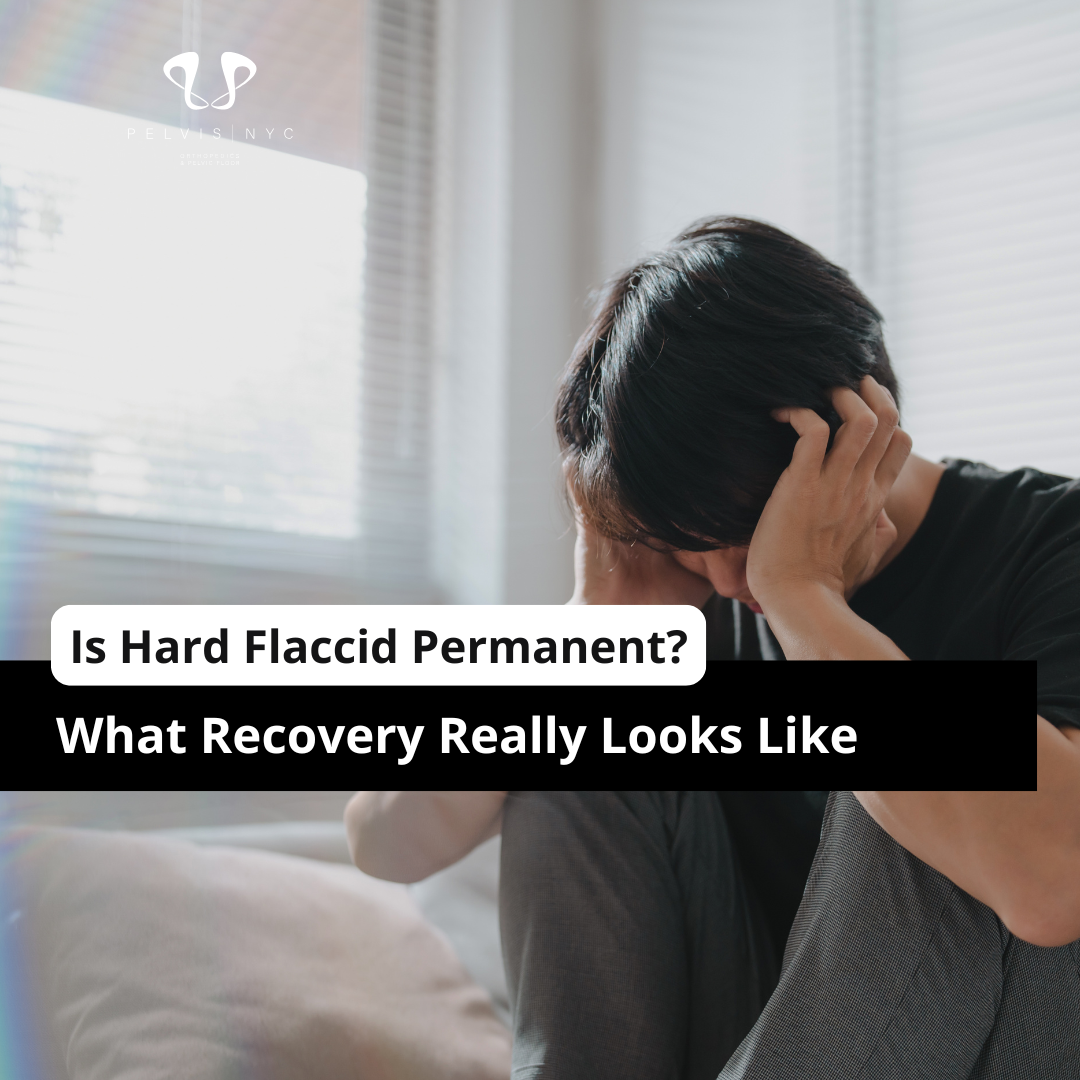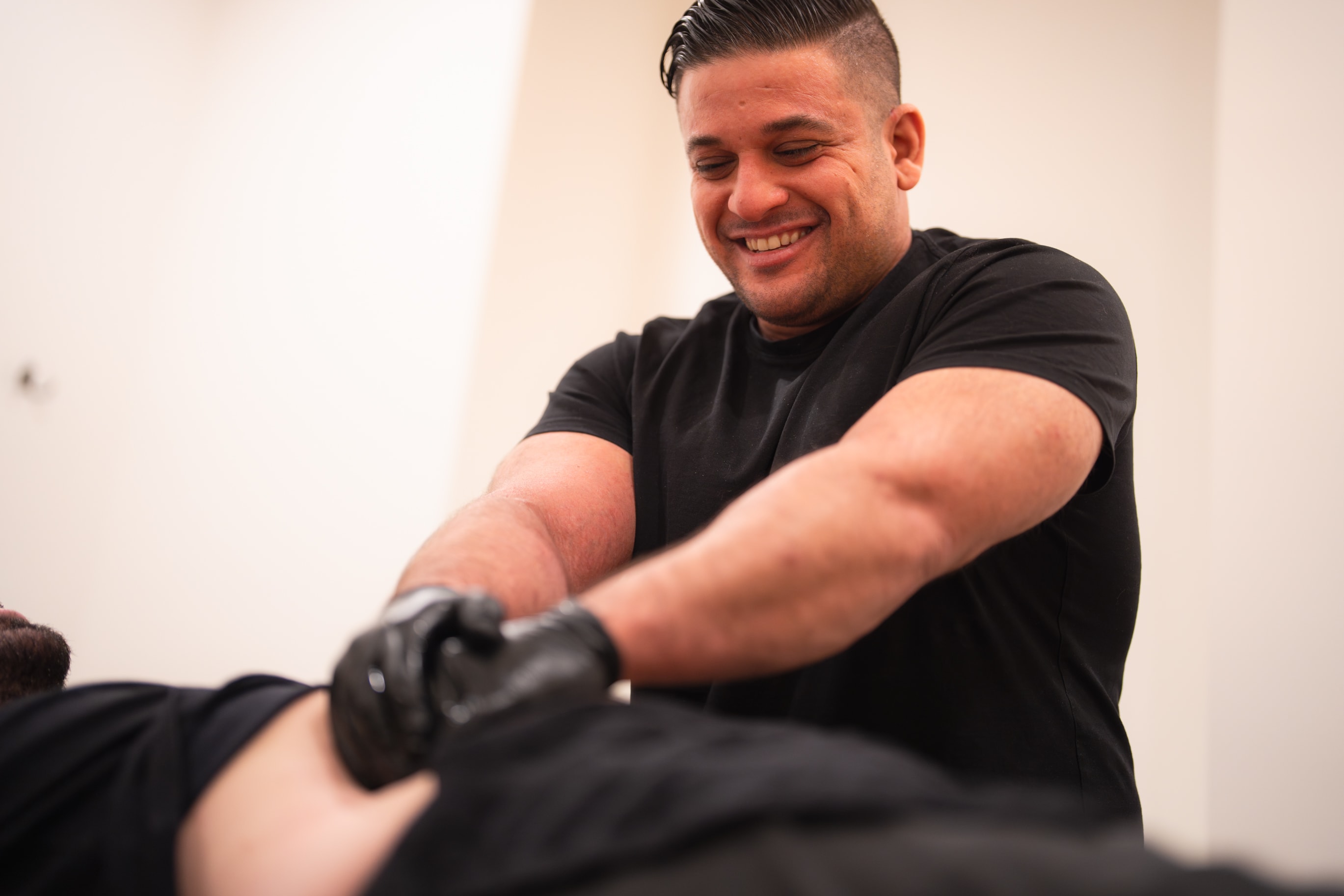Is Hard Flaccid Permanent?
Hard flaccid is not considered permanent in most cases. While symptoms can persist for months or even years, clinical experience and emerging research show that many individuals improve—or fully recover—once the underlying pelvic floor and nervous system dysfunction is properly treated.
Proper diagnosis and clinical diagnosis are crucial for effective management of Hard Flaccid Syndrome (HFS). Diagnosis typically involves a review of medical history and physical examination to rule out other conditions, as there are no definitive laboratory or imaging tests for HFS. It is essential to note that HFS is not currently recognized as a formal medical diagnosis, but it is often associated with chronic pelvic floor muscle tension and nerve irritation.
Recovery depends less on time and more on accurate diagnosis, pelvic floor–focused care, and nervous system regulation.
Hard Flaccid Syndrome
Hard flaccid syndrome (HFS) is a functional pelvic health condition in which the penis feels semi-rigid or tense while flaccid, often accompanied by pain, numbness, erectile difficulty, or pelvic discomfort.

HFS primarily affects men in their 20s and 30s.
Although HFS is not yet formally classified in major diagnostic manuals, it is increasingly recognized by:
- Pelvic floor physical therapists
- Urologists
- Sexual medicine specialists
The proposed mechanism for HFS involves pathological activation of the pudendal-hypogastric reflex, leading to excessive sympathetic activity. This dysregulation can result in persistent muscle contraction and disruption of normal pelvic and erectile function.
Importantly, hard flaccid is not a structural penile disorder. It is best understood as a neuromuscular and pelvic floor regulation issue, which is why it is often reversible.
Hard Flaccid Syndrome Symptoms
Common symptoms include:
- Semi-rigid or “hard” flaccid state
- Constant rigidity
- Decreased penile sensation or numbness
- Numbness
- Hollow feeling in the penis
- Penile, perineal, or pelvic pain
- Painful ejaculation
- Weaker erections or difficulty maintaining erections
- Cold, tight, or disconnected feeling
- Urinary symptoms such as painful urination and decreased force of the urine stream
- Heightened anxiety around sexual performance
Symptoms can fluctuate based on posture, physical activity, arousal, and stress levels.
Many patients notice symptom onset after:
- Chronic stress or anxiety
- Prolonged sitting
- Heavy lifting or intense exercise
- Sexual overuse or edging
- Pelvic trauma or strain
These triggers support the idea that hard flaccid is functional rather than permanent damage.
Many men self-diagnose hard flaccid syndrome by reading online forums, as it is not widely recognized by healthcare professionals.
Is hard flaccid permanent? The connection to the Pelvic Floor

The pelvic floor plays a critical role in sexual function, blood flow, and nerve signaling. It also supports pelvic organs such as the bladder, urethra, intestines, and rectum.
When pelvic floor muscles, or pelvic muscles, remain chronically tight or guarded, muscular tension becomes a key factor in pelvic floor dysfunction and hard flaccid. This can:
- Compress nerves supplying the penis
- Restrict normal blood flow
- Interfere with relaxation needed for erections
This sustained tension is one of the most consistent findings in people with hard flaccid.
Pelvic Floor Dysfunction
Most cases of hard flaccid involve pelvic floor dysfunction, particularly a hypertonic (overactive) pattern. Pelvic floor muscle dysfunction often contributes to symptoms like pelvic tension, pain, and erectile issues, and physical therapy targeting these muscles is a key component of effective treatment.
This can result in:
- Poor coordination between contraction and relaxation
- Increased pressure on pelvic nerves
- Altered sensory feedback
- Muscle spasm and pelvic floor muscle dysfunction, which are key contributors to hard flaccid symptoms
Because of this, strengthening exercises like Kegels often worsen symptoms, while relaxation-based and coordination-focused therapy tends to help.
At-home pelvic floor exercises are often recommended to complement in-clinic treatments for Hard Flaccid Syndrome.
Erectile Dysfunction
Hard flaccid is often associated with erectile dysfunction, but the mechanism differs from classic ED. Unlike a fully erect penis, the hard flaccid state is characterized by a semi-rigid or firm penis when flaccid, which is distinct from the rigidity seen during a normal erection.
In hard flaccid:
- Blood vessels are usually intact
- Hormone levels are often normal
- The problem lies in muscle tone and nerve signaling
Normal erections require healthy blood flow and proper nerve function. The presence or absence of morning erections can be an important symptom or diagnostic indicator, often associated with overall erectile health and hormonal balance.
This is why medications alone frequently fail to resolve symptoms.
Erectile Function
Healthy erectile function requires:
- Adequate blood flow
- Clear nerve signaling
- Pelvic floor muscles that can relax fully
Healthy sexual arousal depends on the proper function of erectile tissue and the relaxation of smooth muscle within the penis.
When the pelvic floor is stuck in a protective, contracted state, erections may feel weaker or inconsistent—even when physical structures are healthy. Pathological smooth muscle contraction of erectile tissue, often triggered by excessive sympathetic activity, can also contribute to hard flaccid symptoms and disrupt normal sexual arousal.
Restoring erectile function requires retraining, not forcing performance.
Chronic Pelvic Pain
Hard flaccid often overlaps with chronic pelvic pain conditions in men, including:
- Chronic prostatitis / CPPS
- Pelvic myalgia
- Pudendal nerve irritation
Chronic pain is a key component of Hard Flaccid Syndrome (HFS) symptoms, contributing significantly to the physical discomfort and sensory changes experienced by those affected.
Studies published in The Journal of Urology show that men with chronic pelvic pain frequently improve with pelvic floor physical therapy focused on muscle relaxation and neuromuscular re-education, reinforcing that these conditions are treatable.
Pathological Activation
A key concept in hard flaccid recovery is pathological activation of the nervous system.
This refers to:
- Ongoing fight-or-flight signaling
- Persistent pelvic muscle guarding
- Heightened pain sensitivity
The sympathetic nervous system and increased sympathetic tone play a key role in perpetuating symptoms of hard flaccid. Excessive sympathetic activity—often resulting from stress, injury, or nerve dysfunction—can lead to persistent muscle contraction and ongoing symptoms.
The nervous system can learn this pattern—but with proper intervention, it can also unlearn it.
Diagnosing Hard Flaccid Syndrome
There is no single test for hard flaccid.
Diagnosis typically involves:
- Detailed symptom history
- Physical examination, including palpation for penile hardness, tenderness, and assessment of muscle tone
- Identification of risk factors that may contribute to the condition
- Pelvic floor muscle assessment
- Ruling out vascular or structural disease
A clinician trained in male pelvic health can identify:
- Excessive pelvic muscle tone
- Trigger points
- Breathing and postural contributors
- Movement patterns that perpetuate symptoms
Proper diagnosis of hard flaccid syndrome is primarily clinical, based on patient history and symptoms, as there is no definitive laboratory test. Identifying risk factors and conducting a thorough physical examination are essential steps to ensure accurate assessment and effective management. Correct diagnosis is one of the strongest predictors of recovery.
Pain Management
Effective pain management focuses on treating the source, not masking symptoms. Hard flaccid syndrome treatment is a multidisciplinary process that addresses physical, neurological, and psychological factors.
Treatment options for Hard Flaccid Syndrome may include pelvic floor physical therapy, medications for pain management, psychological support, and shockwave therapy. Pelvic floor physical therapy can help reduce symptoms by addressing muscle tension and improving blood flow. Stress reduction techniques and counseling or psychological treatment are also recommended as part of the treatment plan. A biopsychosocial management strategy and a multidisciplinary approach involving urologists, physiotherapists, and mental health professionals is often necessary for effective management.
Evidence-based strategies include:
- Pelvic floor manual therapy
- Breathing retraining
- Nervous system down-regulation
- Activity modification
Pain reduction often occurs gradually as muscle tone and nervous system balance normalize.
Hard Flaccid
So, is hard flaccid permanent?
For the majority of patients, no.
Clinical outcomes consistently show:
- Reduced pain
- Improved erectile quality
- Normalization of flaccid state
- Improved confidence and quality of life
Delays in recovery usually stem from:
- Misdiagnosis
- Over-strengthening the pelvic floor
- Ignoring nervous system involvement
Hard Flaccid Cured: What Recovery Really Means
Many patients describe their condition as “cured” once:
- The penis returns to a normal flaccid state
- Erections feel reliable and natural
- Pain and tension resolve
Others experience occasional mild symptoms during stress—but know how to manage them effectively.
Lifestyle Modifications for Hard Flaccid Recovery
Lifestyle modifications play a crucial role in supporting recovery from hard flaccid syndrome (HFS) and managing symptoms such as erectile dysfunction, penile pain, and chronic pelvic pain syndrome. By making targeted changes to daily habits, individuals can help reduce muscle tension, improve blood flow, and ease the discomfort associated with hard flaccid.
Key lifestyle strategies include:
- Stress Reduction: Chronic stress is a major contributor to muscle tension and pelvic pain. Incorporating relaxation techniques—such as deep breathing exercises, meditation, or gentle yoga—can help calm the nervous system and reduce the risk of symptom flare-ups.
- Physical Activity: Engaging in regular, moderate exercise supports healthy blood flow and overall pelvic health. Activities like walking, swimming, or cycling (with proper seat adjustments) can be beneficial, while avoiding exercises that strain the pelvic floor or involve heavy lifting.
- Posture Awareness: Prolonged sitting and poor posture can increase pressure on the pelvic floor muscles, worsening hard flaccid symptoms. Taking frequent breaks, using ergonomic seating, and practicing good posture can help relieve pelvic tension.
- Healthy Sexual Habits: Avoiding aggressive or prolonged masturbation and allowing adequate recovery time between sexual activities can prevent further irritation of the pelvic floor and penile tissues.
- Hydration and Diet: Staying well-hydrated and maintaining a balanced diet can support tissue health and reduce inflammation, which may help with chronic pelvic pain and erectile function.
- Sleep Hygiene: Prioritizing restful sleep allows the body to recover and helps regulate the nervous system, which is essential for managing hard flaccid syndrome symptoms.
By integrating these lifestyle modifications, individuals with hard flaccid can take an active role in their recovery. These changes not only help manage current symptoms like penile pain and erectile dysfunction but also support long-term pelvic health and overall well-being. For best results, lifestyle adjustments should be combined with professional guidance from a pelvic floor specialist.
Getting Specialized Help at Pelvis NYC

If you’re struggling with hard flaccid and wondering whether it’s permanent, working with a pelvic floor specialist matters.
At Pelvis NYC, treatment is led by Dr. Adam Gvili, a pelvic floor physical therapist specializing in male pelvic pain and sexual dysfunction. Care focuses on:
- Identifying pelvic floor dysfunction
- Reducing muscle guarding
- Regulating the nervous system
- Restoring healthy erectile function
Many patients come to Pelvis NYC after months or years of unanswered questions—and finally experience clarity and progress.
👉 If hard flaccid is affecting your quality of life, scheduling a pelvic floor evaluation can be a meaningful first step toward recovery.
Frequently Asked Questions (Schema-Ready)
Is hard flaccid permanent?
No. Most cases improve with proper treatment that focuses on the pelvic floor and nervous system.
How long does hard flaccid last?
Recovery timelines vary, but many people see improvement within weeks to months once treatment begins.
Can anxiety make hard flaccid worse?
Yes. Chronic stress can increase pelvic muscle tension and prolong symptoms.
Are Kegels good for hard flaccid?
Usually no. Strengthening exercises often worsen symptoms when muscles are already overactive.
Can hard flaccid be cured?
Many patients experience full or near-full resolution of symptoms with specialized care.











